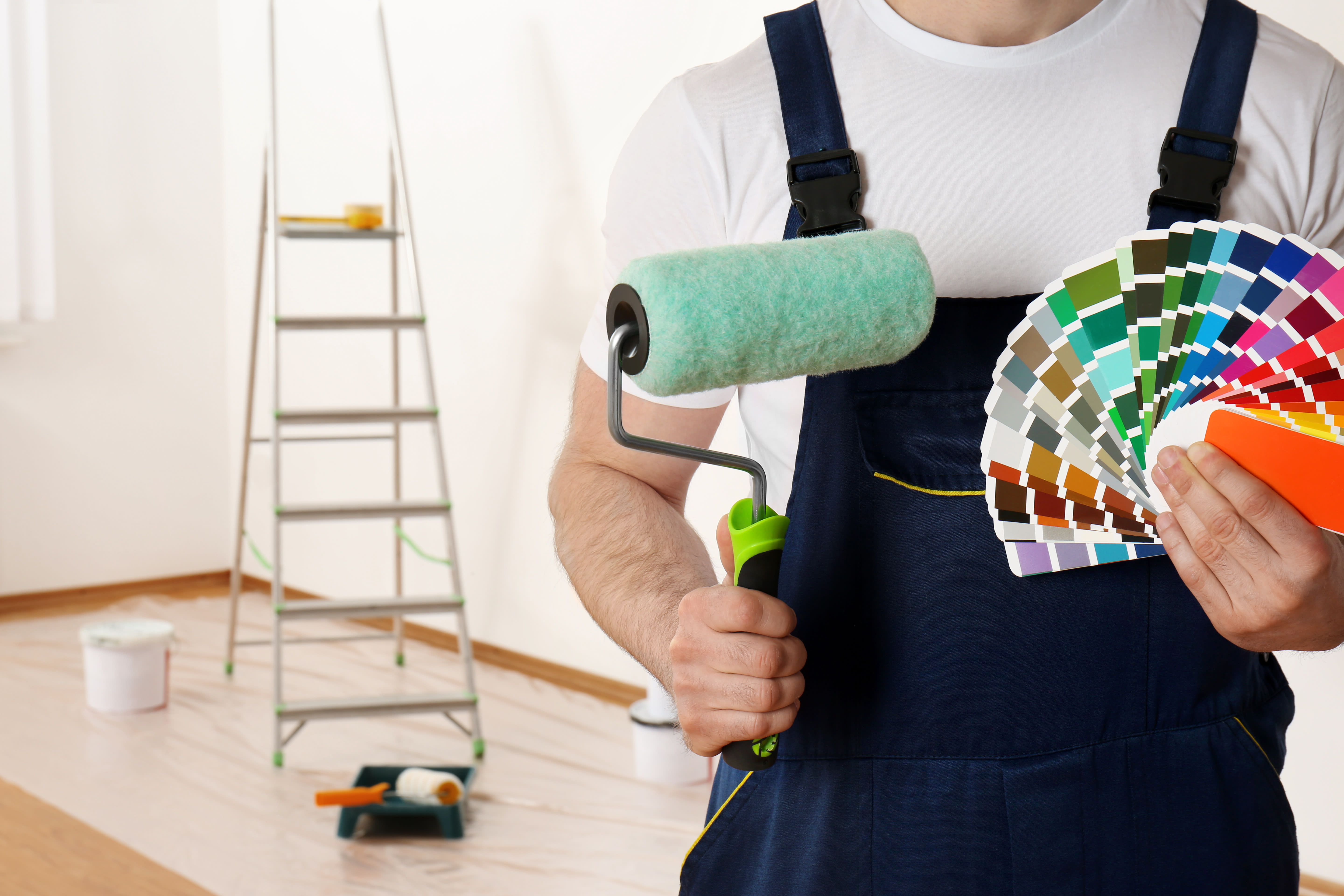Checking Out the Various Types of Paint: An Overview for every single Task
Exploring the numerous kinds of paint is crucial for accomplishing the preferred outcome in any kind of job. From water-based options that offer benefit to oil-based paints known for their resilience, each choice has its values. Specialized paints can include unique textures or surfaces, while green options provide to those looking for sustainability. Recognizing these differences can greatly affect the success of a painting endeavor. What factors should one consider when making the right option?
Recognizing Paint Types: Water-Based vs. Oil-Based
Paint types can markedly impact a job's end result, and recognizing the differences between water-based and oil-based paints is vital for educated decision-making. Water-based paints, frequently described as latex paints, are composed of water as the main solvent. They completely dry quickly, send out less unpredictable natural compounds (VOCs), and are easy to tidy up with soap and water. This makes them a prominent selection for interior applications and atmospheres where air high quality is a problem.
In comparison, oil-based paints use organic solvents, offering a resilient, shiny surface perfect for surfaces revealed to tear and use, such as trim and closets. They take longer to completely dry, call for mineral spirits for clean-up, and have a more powerful odor. corpus christi tx paint shop. Picking between these two types depends on the particular requirements of the project, considering factors such as preferred surface, application setting, and simplicity of upkeep. Each kind has distinct benefits and constraints, guiding the option process
The Complete Matters: Choosing Between Matte, Satin, and Gloss
When choosing a paint surface, the option in between matte and shiny choices considerably influences both aesthetic appeals and functionality. Matte surfaces provide a subtle, non-reflective look that can conceal surface area flaws, while shiny coatings offer sturdiness and simplicity of cleaning. Recognizing the advantages and factors to consider of each can aid in making a notified choice for any type of paint job.
Matte Finish Benefits
Although lots of house owners discuss the advantages of various coatings, matte paint offers distinct benefits that make it a popular option for both exterior and interior applications. Among the key benefits of matte coating is its ability to hide surface area imperfections, producing a smoother appearance on wall surfaces. This top quality is particularly helpful in older homes or spaces with unequal surfaces. Furthermore, matte paint takes in light instead than mirroring it, which can improve the visual of a room by supplying an extra sophisticated and low-key appearance. Matte coatings are often much easier to touch up than glossier choices, as they can blend a lot more perfectly when used over existing paint. Overall, matte paint is a superb option for those seeking an improved and elegant finish.
Shiny Finish Considerations
A shiny coating can dramatically change the assumption of a space, providing a sleek and reflective high quality that boosts both shade vibrancy and light within a space. This finish is commonly preferred for high-traffic locations and surface areas like bathroom and kitchens, where sturdiness and simplicity of cleaning are essential. Its reflective nature can highlight flaws on walls, making appropriate surface prep work crucial. Shiny paints likewise tend to reveal finger prints and spots quicker, necessitating normal maintenance. Furthermore, lights plays a significant function; in brilliant environments, a glossy finish may develop glow, impacting the overall aesthetic. Cautious consideration of the particular application and environment is essential when picking a shiny surface for any kind of task.
Specialty Paints: When to Make Use Of Textured or Chalk Paint
Specialty paints, such as distinctive and chalk paint, offer one-of-a-kind visual and sensible benefits that can boost numerous surfaces. Distinctive paint is ideal for producing depth and measurement on walls, hiding imperfections while adding a three-dimensional feel. It is specifically advantageous in high-traffic areas where sturdiness and aesthetic rate of interest are necessary.

Both kinds of specialized paints can change areas, but picking the appropriate one depends upon the desired effect and surface area demands. Distinctive paint might fit larger areas, while chalk paint can rejuvenate smaller things, showcasing imagination and individual design in any job.
Outdoor Paints: Shielding Your Surface Areas From the Components
Exterior paints are necessary for protecting surfaces versus various climate condition. Recognizing their climate resistance functions, correct surface preparation demands, and reliable application methods can considerably improve sturdiness and efficiency. This area will outline crucial factors to consider for selecting and utilizing outdoor paints effectively.
Climate Resistance Features
Weather condition resistance is a crucial function of outside paints, as it figures out how well surface areas can withstand the rough elements of nature. Top quality outdoor paints are formulated to stand up to damages from UV rays, wetness, and temperature variations. UV resistance warranties shades remain lively gradually, protecting against fading and discoloration. Moisture resistance shields against mold and mildew and mold, which can endanger the stability of surfaces. Furthermore, paints with superb temperature level resistance can expand and acquire without fracturing, preserving their safety top qualities. When picking outdoor paints, it click here is essential to take into account these weather condition resistance features, as they add to the durability and resilience of painted surface areas, ensuring they remain visually pleasing and useful regardless of exposure to the aspects.
Surface Area Preparation Needs
Proper surface preparation is an essential step in attaining the most effective outcomes with exterior paints. To guarantee optimal bond and durability, surface areas must be thoroughly cleansed, removing mold, dust, and oil. This can be achieved making use of a pressure washing machine or a scrub brush with an ideal cleansing service. As soon as cleaned, surface areas ought to be checked for any type of peeling or flaking paint, which must be scuffed away to create a smooth foundation. Repairing any type of cracks or openings is also vital, as these can permit wetness seepage. In addition, fining sand rough locations advertises better paint adhesion. Lastly, applying a guide suited for outdoor use can boost the paint's efficiency, guaranteeing a long-lasting finish that stands up to the components. Appropriate prep work is key to an effective outside painting task.
Application Strategies Tips
While applying outdoor paints, it is vital to utilize effective strategies that assure surface areas are well-protected against the aspects. Initially, choose the appropriate day for painting; low moisture and light temperatures boost bond and drying out. Prepping the surface extensively-- cleaning, sanding, and priming-- ensures much better paint adhesion and sturdiness. Using high-grade brushes or rollers can provide a smoother coating, while spray paint might cover huge locations efficiently. Applying paint in thin, even coats prevents drips and runs. It is a good idea to follow manufacturer instructions regarding drying out times in between coats. Confirm correct ventilation during application to facilitate drying and reduce direct exposure to fumes. These techniques substantially boost the durability and performance of outdoor paint.
Eco-Friendly Options: Low-VOC and Zero-VOC Paints
As customers end up being progressively conscious of the ecological influence of their options, low-VOC and zero-VOC paints have become preferred options. These paints are developed to contain fewer unstable natural substances (VOCs), which are chemicals that can evaporate into the air and add to air pollution and illness. Low-VOC paints typically have a limited quantity of VOCs, while zero-VOC paints have negligible degrees, making them safer for both indoor and outside use.
The benefits of utilizing zero-voc and low-voc paints prolong past environmental factors to consider; they also boost interior air quality, minimizing the threat of allergic responses and breathing problems. Lots of suppliers currently provide a selection of colors and surfaces in environment-friendly alternatives, making it much easier for customers to locate appropriate items for their jobs. By selecting these paints, people can add to a healthier setting while still attaining the visual they prefer in their areas.
Tools and Strategies for a Remarkable Application
Achieving a flawless paint application needs the right devices and techniques, which can greatly enhance the result. Choosing the ideal brush or roller is crucial; brushes function well for edges and complex areas, while rollers cover bigger surfaces effectively. Making use of premium products assures far better paint distribution and reduces streaks. For optimal results, surface preparation is essential. This includes cleansing, sanding, and priming surface areas to promote attachment.
Technique additionally plays a substantial function. The "W" method with a roller assists to evenly disperse paint, while long, smooth strokes with a brush avoid visible lines. Operating in areas permits better control and blending. Furthermore, using slim layers is preferable to thick layers, reducing the risk of drips and irregular textures. Keeping a wet side during application aids achieve seamless modifications in between locations. By integrating these techniques and tools, one can achieve a polished and professional surface.
Tips for Keeping and Caring for Your Painted Surfaces
Appropriate maintenance and treatment of coloured surfaces can greatly expand their life expectancy and maintain their appearance. Routine cleansing is necessary; using a soft fabric or sponge with light soap and water can remove dust and dirt without damaging the paint. It is suggested to stay clear of abrasive cleansers or scrubbing pads, as these can damage the surface area. Additionally, applying a fresh coat of paint every couple of years can protect and invigorate the color against wear.
For exterior surface areas, inspecting for signs of peeling off or fading consistently is very important. Quickly dealing with any kind of issues stops further damages. In areas vulnerable to dampness, such as bathrooms, using mold-resistant paint and guaranteeing proper air flow can help preserve the stability of the paint. Making use of protective coatings can shield versus UV rays and spots, ensuring that painted surface areas stay vibrant and enticing for years to come, ultimately improving the total aesthetic of the area.

Often Asked Inquiries
Can I Mix Different Types of Paint Together?
Mixing various sorts of paint is generally not suggested, as it can lead to concerns like poor attachment, irregular texture, or unexpected chain reaction. It's best to make use of compatible paints for perfect results and longevity.

How Do I Correctly Shop Leftover Paint?
To appropriately store leftover paint, seal the container snugly, label it with the date and shade, and keep it in a cool, dry place far from straight sunshine and severe temperatures for suitable conservation.
What Is the very best Method to Take Care Of Unused Paint?
The best way to throw away unused paint is to examine local policies, as many areas have marked contaminated materials facilities. Think about contributing functional paint to community organizations or schools for their jobs.
How Can I Inform if Paint Is Still Great to Utilize?
To figure out if paint is still excellent, analyze its scent, uniformity, and shade. If it appears apart, has an undesirable smell, or shows considerable changes in structure, it's likely no much longer functional.
Are There Age Restrictions for Purchasing Paint Products?
In lots of areas, there are no certain age limitations for acquiring paint items. Some shops may require clients to be at the very least 18 years old, especially for products consisting of solvents or dangerous products.
Paint types can significantly influence a job's end result, and understanding the differences in between water-based and oil-based paints is crucial for informed decision-making. Water-based paints, typically referred to as latex paints, are composed of water as the main solvent. In contrast, oil-based paints make use of natural solvents, providing a long lasting, glossy coating perfect for surface areas subjected to tear and put on, such as trim and cabinets. Specialized paints, such as distinctive and chalk paint, deal one-of-a-kind aesthetic and practical advantages that can enhance numerous surfaces. In locations prone to dampness, such as shower rooms, using mold-resistant paint and guaranteeing correct ventilation can help keep the honesty of the paint.